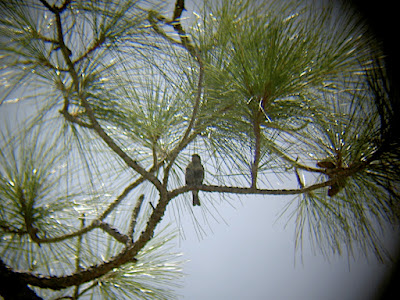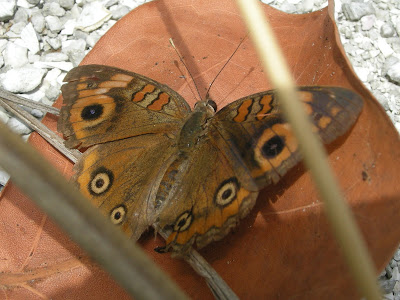 Laura, January 17, 2009
Laura, January 17, 2009 - Tom Green Co, TX
Yesterday, Monday, was when Laura passed away in her sleep.
Laura Packer, Audubon president loved natureThe
Texbirds notice from Lorie Black (of
Big Country Audubon) is fairly succinct.
Randy, Laura's husband, posted "Courage, Faith, and Love" to their
CarePages yesterday:
After battling cancer for months, Laura's courageous and loving spirit passed from her body and this earth around 12:30 p.m. today. Since I know that most of you that have followed these posts know her well, I don't have to describe what a wonderful individual she was in so many, many ways. I know that memories of her kindness and unselfish love for so many will live on in our hearts as we travel on through life. She wanted all of you to know how much she loved you and how much your thoughts and prayers meant to us. Thank you.

November 6, 2007 - we're pointing at a Brant we chased in Andrews, TX
Matt and I are planning to attend the funeral in Abilene on Friday, after which we will make a bee-line for Dallas so we can be on the red-eye flight to Tampa. Had the services been set for Monday, I'd have been tempted to bump the trip back a little, but Laura would have wrung my neck if she got wind of bumping birding down from being the top priority. It was such an honor and privilege to spend two years in her training, sharing meals (read: she fed me when I had no idea which way was up),
challenging my ID skills, sharing freezer space (read: I also had no freezer), and she certainly nurtured my social void with sage wisdom. That was quite the run-on sentence, so I'll continue with eternal gratitude for her guidance in matters of life, relationships (our husbands seem to be clones), compassion, curiosity, cooking, you name it... Different views on faith never clashed in spite of our fairly steady discussions.
The memories with her are etched in smiles and laughter, and the most harsh thing she ever said (to my knowledge!) has become one of my favorite quotes (she cited Fiddler on the Roof). "May the Lord bless and keep [the Czar]... far away from us!"
Ultimately, Matt and I based the decision to marry earlier than anticipated on the travel-ability of my dad and Laura. Pseudo-elopement allowed all of those elements to fall into place (by removing everyone, impartially). We made sure that Laura's chemo dictated the timing of our Abilene reception, double and triple and quadruple checking because, well, she's Laura. Not having her there would have been entirely unthinkable for Matt and myself. She hit it off with everyone she came into contact with, since her smile and enthusiasm were contagious. And brains, oh, the brains...
Enough of tonight's ramblings. Eventually, Matt and I will finish our packing and venture forth. Until then, our hearts are very much with Randy, Melissa and Jay, as well as Chewie, with love and support.
"When someone has been such a presence and made such an impact in your life, you take them with you for the rest of it. This is not goodbye." (Matt)
***
Edit:
ABILENE — Laura Grey Packer, 56, died Monday, July 20, 2009, at an Abilene medical center. Services will be 10 a.m. Friday at Hillcrest Church of Christ. Interment will follow in Elmwood Memorial Park directed by The Hamil Family Funeral Home, 6449 Buffalo Gap Road in Abilene. Visitation will be 5 to 7 p.m. Thursday at the funeral home.
Obituary
Laura Grey Hejl Packer
Laura Grey Packer, 56, of Abilene, TX passed away on July 20, 2009 in Abilene, TX.
Visitation will be 5 – 7 p.m., Thursday, July 23, 2009 at the Hamil Family Funeral Home, 6449 Buffalo Gap Road.
Funeral services will be held at 10 a.m., Friday, July 24, 2009 at Hillcrest Church of Christ, 650 E Ambler Ave, with Dalvin Hampton, of Waxahachie, TX, officiating. Burial will follow at Elmwood Memorial Park. Arrangements are by the Hamil Family Funeral Home.
Laura was born in Austin, TX to J.C. and Betty Hejl on September 4, 1952. She went to elementary school in Tyler, and secondary schools in Corpus Christi and Conroe. She married Randy Packer on August 5, 1972 in the home of her parents in Abilene, TX. She graduated from Abilene Christian College after studying art and office administration. She initially worked for Abilene Christian College, local banks, accounting firms, and oil and gas concerns before leaving the job market to have a family. She often said she had found her purpose in life in raising her children. She was an active school volunteer and served as PTA president. She served as president of the Abilene Quilter's Guild and was an accomplished quilter having won best in show each time she entered a quilt at the West Texas Fair. She learned tatting directly from her grandmother, designed and created numerous quilts for family and friends, and created custom quilts for the public until carpal tunnel syndrome restricted that activity. She was an avid “birder” and was currently serving as president of the Big Country Audubon Society. She traveled in a number of countries and clearly informed her fellow travelers that “every trip is a birding trip.” At Dyess Air Force Base, she created and maintained the base avian checklist which is posted on the Department of Defense Partners In Flight website with links to pictures, most of which she took. Laura assisted with spring and fall quail counts and helped the base golf course maintain its Audubon International Wildlife Sanctuary status. She was awarded a special medallion by Dyess Air Force Base for her services as a contractor and tireless volunteer. She served as a host mom and mentor for international students, several of which she taught to drive using her own car.
Laura is survived by her husband Randy, son Jay, daughter-in-law Amy, daughter Melissa, brother Jerry Hejl, sister-in-law Angie, brother Lee Hejl, father and mother J. C. and Betty Hejl, father-in-law and mother-in-law C.E. and Virginia Packer, and many other family and friends from around the world who thought of her as a true sister or mother.
Pallbearers will be Kim Walton of Clyde, TX, Wyatt Walton of Clyde, TX, Danny Walters of Buffalo Gap, TX, Doug Boone of Parker, CO, Wayne White of Parker, CO, Mark Lansdown of Castle Rock, CO, Lowell Johnston of Abilene, TX, Tim Colglazier of Fort Worth, TX, and Nathan Maxson of Houston, TX.
Memorials may be given to
Big Country Audubon Society
P.O. Box 569
Abilene, TX 79604
Community Foundation of Abilene for the ARMC Nursing Scholarships
500 Chestnut Street
Abilene, TX 79602
Abilene Cancer Society
209 South Danville
Abilene, TX 79605
The Packer and Hejl families wish to extend our sincere thanks to Dr. Anton Melnyk, Dr. Mark Reedy, Dr. Joseph Crumbliss, Dr. George Dawson, the nurses in outpatient surgery at Abilene Regional Medical Center, the nurses at Texas Oncology and the Texas Cancer Center, the nurses and caretakers on the fifth floor at Abilene Regional Medical Center, Hospice of the Big Country, and all of the members of Hillcrest Church of Christ who loved and supported us so tenderly during our recent struggles.
(ARN obit link)








































 (Hemileuca maia) larva
(Hemileuca maia) larva


















